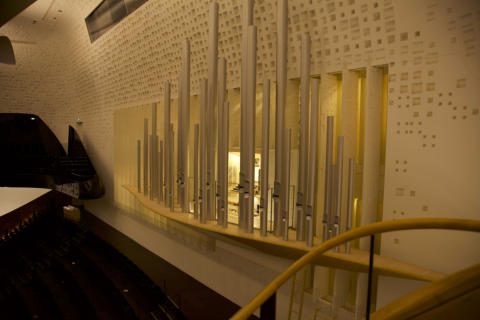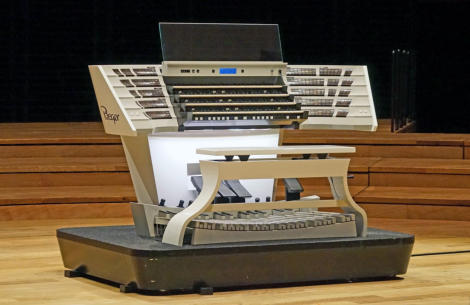


ORGANS OF PARIS © 2024 Vincent Hildebrandt HOME ALL ORGANS
Cité de la Musique-
Philharmonie de Paris
221, Avenue Jean Jaurès, 75019 ParisLa grande salle de la Philharmonie
Amphithéâtre de la Cité de la musique >
Poikilorgue >
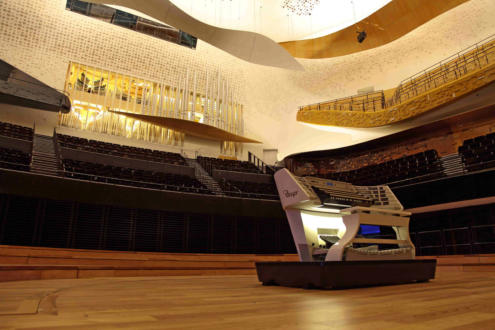
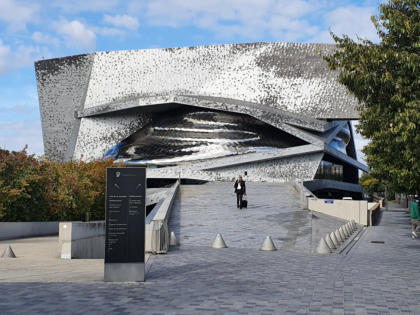

E1
The goal was to create a contemporary instrument that would
serve universal organ music. Rieger Orgelbau in Austria was
commissioned to build this instrument. It was agreed in advance
that the harmony would be achieved by the French organ
builder Michel Garnier, a member of Rieger's team since 2000,
thus giving the whole a French character.
The keyboard of the Grand Orgue has a "classical" core
composed of a choir of Principal stops, starting at the 16′ and
progressing to the Plein jeu and the Cymbal. A similar, but
narrower-sized, configuration is found on the Positive. Around
the classical nuclei of the Great Organ and the Positive, a rich
selection of additional registers has been placed. The Récit has
an even wider range of 8' stops. The fourth keyboard includes
both the Expressive Solo, the Chamades, and the Resonance
Division, which has been conceptualized as a floating
complement to the Grand Orgue and Pedale divisions and has
the necessary mutations to play classical French literature. The
pedal is very full, starting with three stops of 32′ and eight of 16′
to give that rich base that only an organ can add to great
orchestral works.
A mechanical console is accessible from the back of the organ,
and is located on a small gallery projecting into the auditorium
as one of the acoustic "clouds" of the hall.
A second mobile console is available on stage. Its characteristics
include, apart from the automatic recall of the data saved by the
organist – combinations, sequencer, archive – the possibility for
the instrumentalist to adjust the console ergonomically as he
wishes: lateral position, depth and distance of the pedalboard,
height of the keyboard block.
Following the architect's wishes, the organ façade gives a
minimalist appearance when the general expression box is
closed. Only a group of Montre 16′ pipes, located around the
mechanical console, reveals the presence of an organ. However,
when the general expression box is opened, the inside of the
organ is spectacularly visible. Its impact can be increased by
illuminating the interior with a variety of colors that visually
reflect the atmosphere of the work being performed.
Vidéo Au cœur de l'orgue de la Philharmonie de Paris
L’orgue de l’amphithéâtre de la Cité de la musique

The Philharmonie de Paris is an exceptional
architectural hub bringing together the Philharmonie 1,
the new building designed by Jean Nouvel that houses
the Great Hall opened in January 2015, and the
Philharmonie 2, the former Cité de la musique
designed by Christian de Portzamparc in 1995.
Neither a "shoebox" hall (like the Musikverein in
Vienna), nor a "vineyard" room (like the Berlin
Philharmonic), the Great Pierre Boulez Hall of the
Philharmonie invents a new model, that of an
enveloping and modular room. An architectural,
scenographic and acoustic innovation. Architect Jean
Nouvel and the hall's chief acoustician, Sir Harold
Marshall, designed the hall in collaborative sessions
combining architecture, acoustics and scenography.
Despite its capacity of 2,400 seats, the hall establishes
a real intimacy. A very real sensation, since the distance
between the conductor and the last spectator is only
32 meters (against 48 meters at the Salle Pleyel). Jean
Nouvel describes the scenography as follows: "The
evocative room of immaterial layers of music and light
suspends listeners-spectators in space on long
balconies ... This suspension creates the impression of
being surrounded, immersed in music and light. »
Jean Nouvel, assisted by Métra et associés (associated
with the concert hall), developed with Marshall Day
Acoustics and Ducks Scéno a bold system of
cantilevered balconies and floating clouds combining
envelopment, intimacy and spatiality. The stage offers
the possibility of hosting any type of orchestral
formation, even the most imposing.
Source
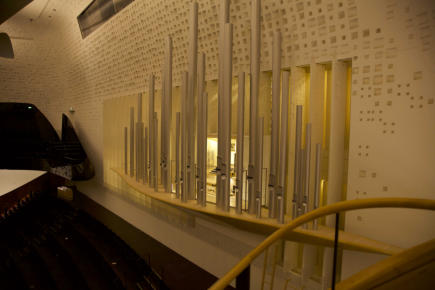
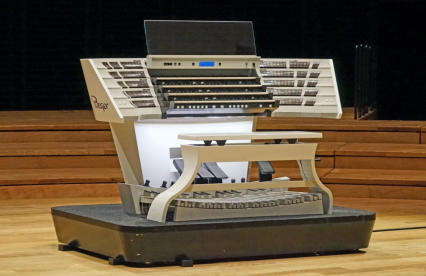
Organs of Paris
Cité de la Musique-
Philharmonie de
Paris
221, Avenue Jean Jaurès, 75019 ParisLa grande salle de la Philharmonie
Amphithéâtre de la Cité de la musique >
Poikilorgue >
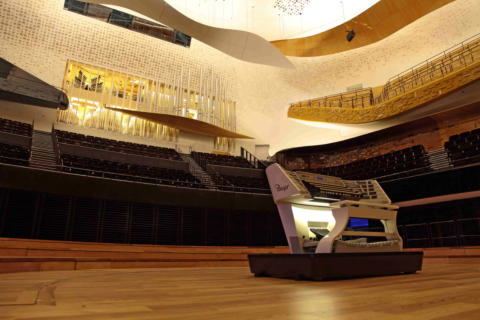
ORGANS OF PARIS © 2024 Vincent Hildebrandt ALL ORGANS
E1
The goal was to create a contemporary instrument that would
serve universal organ music. Rieger Orgelbau in Austria was
commissioned to build this instrument. It was agreed in advance
that the harmony would be achieved by the French organ
builder Michel Garnier, a member of Rieger's team since 2000,
thus giving the whole a French character.
The keyboard of the Grand Orgue has a "classical" core
composed of a choir of Principal stops, starting at the 16′ and
progressing to the Plein jeu and the Cymbal. A similar, but
narrower-sized, configuration is found on the Positive. Around
the classical nuclei of the Great Organ and the Positive, a rich
selection of additional registers has been placed. The Récit has
an even wider range of 8' stops. The fourth keyboard includes
both the Expressive Solo, the Chamades, and the Resonance
Division, which has been conceptualized as a floating
complement to the Grand Orgue and Pedale divisions and has
the necessary mutations to play classical French literature. The
pedal is very full, starting with three stops of 32′ and eight of 16′
to give that rich base that only an organ can add to great
orchestral works.
A mechanical console is accessible from the back of the organ,
and is located on a small gallery projecting into the auditorium
as one of the acoustic "clouds" of the hall.
A second mobile console is available on stage. Its characteristics
include, apart from the automatic recall of the data saved by the
organist – combinations, sequencer, archive – the possibility for
the instrumentalist to adjust the console ergonomically as he
wishes: lateral position, depth and distance of the pedalboard,
height of the keyboard block.
Following the architect's wishes, the organ façade gives a
minimalist appearance when the general expression box is
closed. Only a group of Montre 16′ pipes, located around the
mechanical console, reveals the presence of an organ. However,
when the general expression box is opened, the inside of the
organ is spectacularly visible. Its impact can be increased by
illuminating the interior with a variety of colors that visually
reflect the atmosphere of the work being performed.
Vidéo Au cœur de l'orgue de la Philharmonie de Paris
L’orgue de l’amphithéâtre de la Cité de la musique
